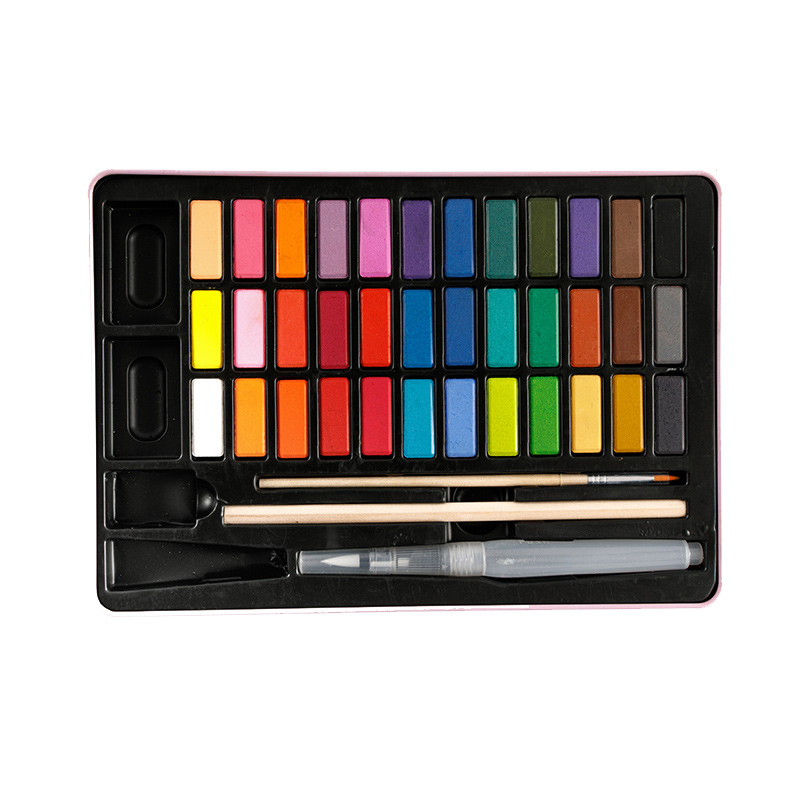Exploring the Beauty of Solid Watercolor: A Guide for Artists
2025-03-28
Watercolor painting has been a popular artistic medium for centuries, celebrated for its fluidity, transparency, and ethereal quality. Among the various forms of watercolor, solid watercolor paints stand out as a versatile and compact choice for artists of all skill levels. Whether you're an experienced painter or a beginner looking to explore this medium, solid watercolors offer unique benefits and creative possibilities. In this blog, we will explore what solid watercolors are, how they are used, and why they might be the perfect choice for your next artistic project.
What Are Solid Watercolors?
Solid watercolors, also known as watercolor pans, are water-based paints that come in small, solid blocks. These blocks are made of pigment mixed with a binder that allows the paint to dry into a solid form. Unlike liquid watercolors, which come in bottles or tubes, solid watercolors are compact and portable, making them an ideal choice for artists who need a convenient, mess-free solution for painting on the go.
Solid watercolors come in various colors and are typically sold in sets that include a range of hues, from vibrant primaries to soft pastels and earth tones. They are activated with water, which is applied with a brush to bring the pigment to life on paper. As the water is mixed with the pigment, it creates a translucent, layered effect that is characteristic of traditional watercolor paintings.
Benefits of Solid Watercolors
1. Portability and Convenience
One of the most significant advantages of solid watercolors is their portability. Unlike tube paints, which can be bulky and require squeezing out onto a palette, solid watercolors are compact and easy to carry. Whether you're traveling, painting en plein air, or working in a small studio space, these watercolor pans allow you to paint without the need for bulky equipment or extra setup.
The solid form makes them ideal for outdoor painting or quick sketches, as you only need a small water container and a brush to start creating. Many artists prefer solid watercolors for their convenience, as they can be used anywhere—whether on a hike, at a café, or in the comfort of their home.
2. Less Mess
Solid watercolors are relatively mess-free compared to liquid watercolors. Since the paint is already in a dry form, there’s no need to worry about accidental spills or the challenge of squeezing the right amount from a tube. You simply wet the surface of the solid watercolor with a brush or a water dropper, making it easy to control how much paint you use. The solid form helps to minimize waste and maintain cleanliness, which is especially beneficial for artists who work in small or shared spaces.
3. Long Shelf Life
Because they are made with high-quality pigments and binders, solid watercolors tend to have a long shelf life. Unlike liquid watercolors, which may dry out or degrade over time, solid watercolors can remain in good condition for many years if stored properly. The airtight packaging often used for watercolor pans helps keep the paints fresh, so you don’t have to worry about them drying up or losing their vibrancy. This makes solid watercolors a good investment for artists who want reliable and lasting materials.
4. Control Over Pigment Concentration
With solid watercolors, you have excellent control over the pigment concentration. By adjusting the amount of water you add to the solid paint, you can create washes that range from pale, transparent layers to deep, intense colors. This flexibility allows you to achieve a wide variety of effects, from delicate gradients to bold, saturated tones. Whether you’re working on intricate details or creating a broad, expressive wash, solid watercolors give you full control over the outcome.
5. Easy to Mix and Layer
Solid watercolors are easy to mix and layer, allowing you to experiment with different color combinations and create a wide range of effects. The rich pigments in watercolor pans blend effortlessly, making it simple to create custom colors or subtle transitions between hues. The transparent nature of watercolors lends itself well to layering, allowing you to build up layers of color and texture to add depth to your artwork.
How to Use Solid Watercolors
Using solid watercolors is simple and requires just a few basic tools: watercolor pans, brushes, and a water container. Here’s a quick guide to getting started:
1. Prepare Your Brushes and Water
Start by choosing the appropriate brush for the type of painting you want to do. A round brush works well for general use, while a flat brush is ideal for broader strokes or washes. Fill a water container with clean water to dip your brush in.
2. Activate the Paint
Dip your brush into the water and gently touch it to the solid watercolor pan. The amount of water you use will depend on the effect you want to achieve. A small amount of water will produce a more concentrated pigment, while more water will create a lighter, wash-like effect.
3. Apply the Paint
Begin applying the paint to your paper or canvas. Watercolor pans allow you to control the intensity of your colors by adjusting the water-to-paint ratio. Experiment with different techniques such as wet-on-wet or wet-on-dry to create various textures and effects.
4. Layer and Blend
Once the first layer of paint dries, you can add more layers to build up depth and intensity. Solid watercolors are perfect for layering, allowing you to create smooth gradients or textured surfaces.
5. Clean Your Brushes
After you’ve finished painting, be sure to clean your brushes thoroughly with water. Since solid watercolors are water-based, they can be easily cleaned off with a bit of soap and water, leaving your brushes ready for your next project.
Tips for Working with Solid Watercolors
- Start with Light Layers: Begin with light washes and gradually build up to darker, more saturated colors. This will help you maintain the translucent quality that watercolors are known for.
- Experiment with Color Mixing: Solid watercolors provide endless opportunities for color mixing. Don’t be afraid to experiment and create your own custom shades by blending different colors together.
- Use High-Quality Paper: To get the best results, always use good-quality watercolor paper that can handle the water without buckling or tearing.
- Keep Your Palette Clean: If you're using a palette to mix colors, be sure to keep it clean to avoid unwanted contamination between colors.
Conclusion
Solid watercolors are a wonderful medium for both beginners and experienced artists alike. Their compact, portable nature, combined with their versatility and ease of use, makes them an excellent choice for artists who want to create beautiful, vibrant works of art with minimal fuss. Whether you are creating detailed illustrations or expressive, loose washes, solid watercolors provide the perfect balance of control, flexibility, and creativity. So grab your brushes, some solid watercolors, and let your creativity flow!



